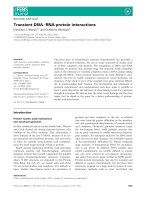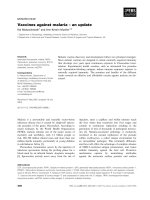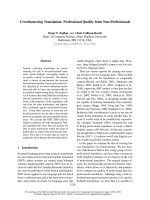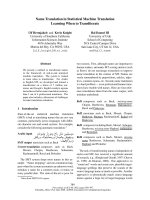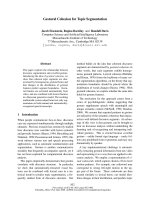Tài liệu Báo cáo khoa học: " Machine Translation already does Work" doc
Bạn đang xem bản rút gọn của tài liệu. Xem và tải ngay bản đầy đủ của tài liệu tại đây (134.23 KB, 2 trang )
FORUM ON MACHINE TRANSLATION
Machine Translation
already does Work
Margaret King
ISSCO
54, rte des Acacias
CH-1227 Geneva, Switzerland
PANELIST STATEMENT
The first difficulty in answering a question like "Does
machine translation work is that the question itself is ill-
posed. It takes for granted that there is one single thing
called machine translation and that everyone is agreed about
what it is. But in fact, even a cursory glance at the systems
already around, either in regular operational use or under
development, will reveal a wide range of different types of
systems.
If we take first the dimension determined by who/what
does most of the work, the machine or the translator or
revisor, at one end of the scale are systems where the human
does not intervene at all during the process of translation -
"batch" systems for convenience here. Even amongst the
batch systems there is considerable variety: the degree of
pre-editing i~ermitted or required varies greatly, as does the
amount of post-editing foreseen. Some systems insist that
anything translated by the machine should require no post-
editing, and thus (sometimes) reject as unsuitable for
machine treatment a part of the text. Others take it for
granted that machine translation will normaly be post-edited,
just as human translation is normally revised. Some systems
aim at giving nothing more than a very rough raw trans-
lation, to be used by the human translator only as a starting
point for producing his own translation. Some systems re-
quire that the document to be translated conform to a
restricted syntax, others leave the author relatively free.
Next comes a class of systems that one might style
"interactive" systems, where the bulk of the work is still
done by the machine, but where the system interacts with a
human to a greater or lesser degree. Such systems may ask
the human, for example, to resolve an ambiguity in the
source text, to choose between a set of target language
terms, to decide on correct use of prepositions, or any com-
bination of the-~e and other similar tasks.
Shifting towards the end of the scale where the bulk of
the work is done by a human translator aided by a computer
system, there are. systems which will automatically insert
identified technical terms, or replace a phrase occurring
repeatedly in the text by its translation wherever it appears,
leaving the rest of the translation to be done by the human
translator, systems where the translator as he produces the
translation can consult specialist or general dictionaries, ei-
ther constructed by the translator himself for the particular
needs of the text, or supplied by the system manufacturer.
Many -indeed most- such systems are allied with clever text-
processing systems specially designed for use by translators.
Finally, although perhaps not strictly machine translation
systems, but certainly of potentially great practical utility to
the working translator, are independent packages, not neces-
sarily integrated into a translator's work station type of en-
vironment. These include automated terminology banks, dic-
tionary look-up facilities, and general tools such as spelling or
grammar checkers.
In all this, I have quite deliberately omitted consideration
of machine translation systems conceived of as primarily
research tools, intended to test the validity of a particular
theory or to experiment with some new proposal, since I take
it that the worry lying behind the original question -and be-
hind the moderator's statement- concerns systems which are
in some way subject to external evaluation, and which can
therefore lead to dissatisfaction. The status of research and
experimental systems as valuable research tools seems quite
uncontentious.
Now, just as machine translation is not a single in-
divisible whole, but rather a range of systems sharing only
the common characteristic that they are used in one way or
another in performing the task of translation, so the need for
machine translation is different, depending on the particular
characteristics of individual situations.
Here, so many factors come into determining what the
real need is that I shall not even attempt to give an exhaus-
tive list, limiting myself instead to a handful of indicative,
but necessarily over-simplified, examples. Take first the ex-
ample of a large translation service, translating documents
essentially very similar to one another, but in great volume
and frequently at very short notice. This is the typical situa-
tion in which what is needed is a batch service, producing
reasonable quality translation which can if necessary be
revised, where the degree of revision to be done depends on
the use to which the translated document is to be put. (If the
point of the document is to inform its readers in very general
terms of what was discussed in a particuler meeeting, per-
haps no revision at all is necessary, if it is to serve as the
basis of discussion in a subsequent meeting, it may require
quite a lot of revision, if it is to serve as the basis of a treaty
or an agreement, it should never have been allowed near a
machine translation system in the first place, and the trans-
lation should be thrown away). In such a situation, an inter-
active system, on the other hand, is likely to be unsuitable,
since the main problem is the bulk of work to be done, and
the translator or revisor is better occupied dealing with those
documents unsuitable for machine treatment or revising
where necessary than in sitting in front of a screen watching
the machine at work.
In a different situation, however, where what is required
is very high quality translation, and where the volume of
translation to be done is a less pressing problem, so that the
main concern is in rationalising the translator's work whilst
contingently increasing his productivity, an interactive sys-
tem may prove to be the ideal choice, especially if the text
type is a mixture of repetitive material which it is boring
(and time-wasting) to translate manually each time it ap-
pears and quite delicate text requiring great care.
In yet another situation the major problem may be the
typical length of documents, combined with a need for speed
and a need for terminological accuracy, so that a single docu-
ment is split over a number of translators working indepen-
dently, but all must use the same translation for certain
terms. Here, the ideal system might well be simply to provide
all the translators with access to a clever text-processor from
within which they could access easily a common term bank,
with all the rest being left to the translator.
There is no need to labour the point: different set-ups
have different problems to solve, and therefore, whether they
know it or not, need different kinds of machine translation
systems.
Now we can return to the original question: machine
translation works when the machine translation system is
able to resolve in a significant measure the particuler trans-
269
lation problems in a particular situation. To put this more
crudely, no-one should try to persuade the translator of
Faust that a batch trunslation system will do him any good
at all, and no-one should try to persuade the translation ser-
vice that churns out several hundred invitations to meetings
every day that an automated dictionary look-up facility will
solve their problems.
Once this is realized, the puzzle contained in people as-
king questions like whether it is a good idea to work on
machine translation in a world where it is demonstrably the
case that machine translation systems exist and are counted
satisfactory by their users begins to go away. The succesful
systems are those where what is provided by the system
matches what is required to solve the real problem, where
the system developers realistically assessed what they could
offer, went ahead and provided that, and where those who
commissioned the construction or purchase of a system had
expectations matched by what was actually delivered.
A final question to those who claim that it is somehow
dangerous or irresponsible to promise to produce a machine
translation system. If one promises and fails (apart of course
from the general principle that one should always try to fulfil
one's promises and not to promise what one cannot deliver),
why is that more damaging to the field than working on
speech-recognition and failing?
270
